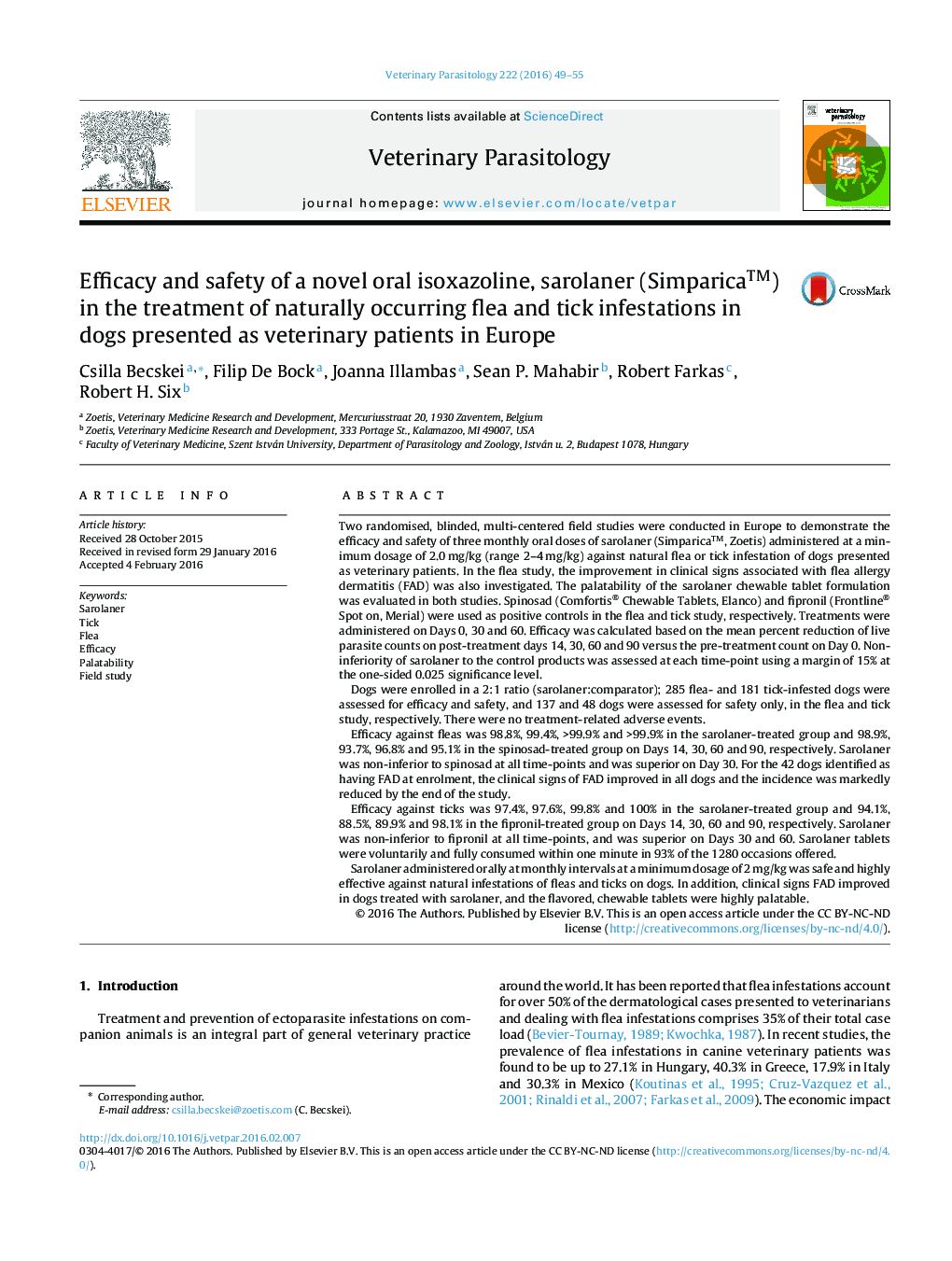| کد مقاله | کد نشریه | سال انتشار | مقاله انگلیسی | نسخه تمام متن |
|---|---|---|---|---|
| 2469840 | 1555654 | 2016 | 7 صفحه PDF | دانلود رایگان |

• Sarolaner was safe and effective for control of fleas and ticks on client owned dogs.
• Flea efficacy was 98.8% and tick efficacy 97.4% within 14 days of first treatment.
• Against fleas, sarolaner was superior to spinosad on Day 30 (99.4% vs. 93.7% efficacy).
• Against ticks, sarolaner was superior to fipronil on Days 30 (97.6% vs. 88.5% efficacy) and 60 (99.8% vs. 89.9% efficacy).
• 93% of sarolaner tablets were accepted free choice.
• Sarolaner was well tolerated alone and concurrently with many common medications.
Two randomised, blinded, multi-centered field studies were conducted in Europe to demonstrate the efficacy and safety of three monthly oral doses of sarolaner (Simparica™, Zoetis) administered at a minimum dosage of 2.0 mg/kg (range 2–4 mg/kg) against natural flea or tick infestation of dogs presented as veterinary patients. In the flea study, the improvement in clinical signs associated with flea allergy dermatitis (FAD) was also investigated. The palatability of the sarolaner chewable tablet formulation was evaluated in both studies. Spinosad (Comfortis® Chewable Tablets, Elanco) and fipronil (Frontline® Spot on, Merial) were used as positive controls in the flea and tick study, respectively. Treatments were administered on Days 0, 30 and 60. Efficacy was calculated based on the mean percent reduction of live parasite counts on post-treatment days 14, 30, 60 and 90 versus the pre-treatment count on Day 0. Non-inferiority of sarolaner to the control products was assessed at each time-point using a margin of 15% at the one-sided 0.025 significance level.Dogs were enrolled in a 2:1 ratio (sarolaner:comparator); 285 flea- and 181 tick-infested dogs were assessed for efficacy and safety, and 137 and 48 dogs were assessed for safety only, in the flea and tick study, respectively. There were no treatment-related adverse events.Efficacy against fleas was 98.8%, 99.4%, >99.9% and >99.9% in the sarolaner-treated group and 98.9%, 93.7%, 96.8% and 95.1% in the spinosad-treated group on Days 14, 30, 60 and 90, respectively. Sarolaner was non-inferior to spinosad at all time-points and was superior on Day 30. For the 42 dogs identified as having FAD at enrolment, the clinical signs of FAD improved in all dogs and the incidence was markedly reduced by the end of the study.Efficacy against ticks was 97.4%, 97.6%, 99.8% and 100% in the sarolaner-treated group and 94.1%, 88.5%, 89.9% and 98.1% in the fipronil-treated group on Days 14, 30, 60 and 90, respectively. Sarolaner was non-inferior to fipronil at all time-points, and was superior on Days 30 and 60. Sarolaner tablets were voluntarily and fully consumed within one minute in 93% of the 1280 occasions offered.Sarolaner administered orally at monthly intervals at a minimum dosage of 2 mg/kg was safe and highly effective against natural infestations of fleas and ticks on dogs. In addition, clinical signs FAD improved in dogs treated with sarolaner, and the flavored, chewable tablets were highly palatable.
Journal: Veterinary Parasitology - Volume 222, 30 May 2016, Pages 49–55